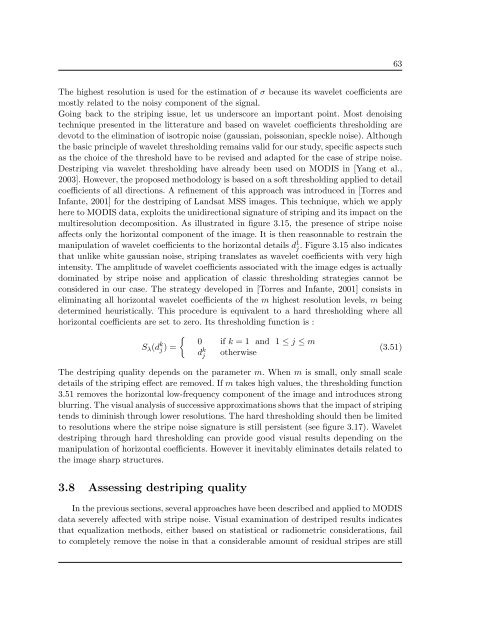Th`ese Marouan BOUALI - Sites personnels de TELECOM ParisTech
Th`ese Marouan BOUALI - Sites personnels de TELECOM ParisTech
Th`ese Marouan BOUALI - Sites personnels de TELECOM ParisTech
You also want an ePaper? Increase the reach of your titles
YUMPU automatically turns print PDFs into web optimized ePapers that Google loves.
63<br />
The highest resolution is used for the estimation of σ because its wavelet coefficients are<br />
mostly related to the noisy component of the signal.<br />
Going back to the striping issue, let us un<strong>de</strong>rscore an important point. Most <strong>de</strong>noising<br />
technique presented in the litterature and based on wavelet coefficients thresholding are<br />
<strong>de</strong>votd to the elimination of isotropic noise (gaussian, poissonian, speckle noise). Although<br />
the basic principle of wavelet thresholding remains valid for our study, specific aspects such<br />
as the choice of the threshold have to be revised and adapted for the case of stripe noise.<br />
Destriping via wavelet thresholding have already been used on MODIS in [Yang et al.,<br />
2003]. However, the proposed methodology is based on a soft thresholding applied to <strong>de</strong>tail<br />
coefficients of all directions. A refinement of this approach was introduced in [Torres and<br />
Infante, 2001] for the <strong>de</strong>striping of Landsat MSS images. This technique, which we apply<br />
here to MODIS data, exploits the unidirectional signature of striping and its impact on the<br />
multiresolution <strong>de</strong>composition. As illustrated in figure 3.15, the presence of stripe noise<br />
affects only the horizontal component of the image. It is then reasonnable to restrain the<br />
manipulation of wavelet coefficients to the horizontal <strong>de</strong>tails d 1 j . Figure 3.15 also indicates<br />
that unlike white gaussian noise, striping translates as wavelet coefficients with very high<br />
intensity. The amplitu<strong>de</strong> of wavelet coefficients associated with the image edges is actually<br />
dominated by stripe noise and application of classic thresholding strategies cannot be<br />
consi<strong>de</strong>red in our case. The strategy <strong>de</strong>veloped in [Torres and Infante, 2001] consists in<br />
eliminating all horizontal wavelet coefficients of the m highest resolution levels, m being<br />
<strong>de</strong>termined heuristically. This procedure is equivalent to a hard thresholding where all<br />
horizontal coefficients are set to zero. Its thresholding function is :<br />
{ 0 if k = 1 and 1 ≤ j ≤ m<br />
S λ (d k j )=<br />
otherwise<br />
d k j<br />
(3.51)<br />
The <strong>de</strong>striping quality <strong>de</strong>pends on the parameter m. When m is small, only small scale<br />
<strong>de</strong>tails of the striping effect are removed. If m takes high values, the thresholding function<br />
3.51 removes the horizontal low-frequency component of the image and introduces strong<br />
blurring. The visual analysis of successive approximations shows that the impact of striping<br />
tends to diminish through lower resolutions. The hard thresholding should then be limited<br />
to resolutions where the stripe noise signature is still persistent (see figure 3.17). Wavelet<br />
<strong>de</strong>striping through hard thresholding can provi<strong>de</strong> good visual results <strong>de</strong>pending on the<br />
manipulation of horizontal coefficients. However it inevitably eliminates <strong>de</strong>tails related to<br />
the image sharp structures.<br />
3.8 Assessing <strong>de</strong>striping quality<br />
In the previous sections, several approaches have been <strong>de</strong>scribed and applied to MODIS<br />
data severely affected with stripe noise. Visual examination of <strong>de</strong>striped results indicates<br />
that equalization methods, either based on statistical or radiometric consi<strong>de</strong>rations, fail<br />
to completely remove the noise in that a consi<strong>de</strong>rable amount of residual stripes are still















